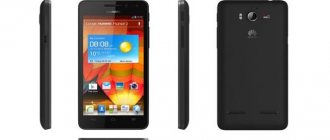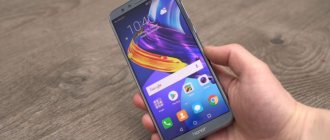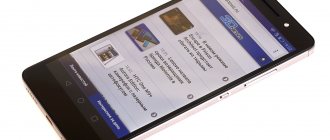Design and usability
The first procedure that any user faces is installing SIM cards. By the way, there are two of them here and both have the Micro SIM form factor. However, you won’t be able to install the cards right away. There are no trays, plugs, slots or other hints on the case as to where to insert the SIM cards.
This can only mean one thing: the back cover of the device is removable. Everything is true, but around the perimeter of the smartphone you will not find any protrusion or recess to pick up the battery compartment cover and this leads to a slight stupor. In fact, you can carefully (if you have nails, of course) pry the lid off anywhere and everything will go on simply.
Having exposed the insides of the device, you will be rewarded for your efforts: there are connectors for SIM cards and a memory card.
By the way, the battery here is non-removable. You can look at it, touch it, but you cannot take it out. This is the approach.
Let's return to the appearance of our hero. The entire front surface is occupied by protective glass (type and generation are not specified). It is slightly recessed against the background of a chrome edging protruding around the perimeter of the smartphone.
Oleophobic coating is present here, but not as effective as in some flagship.
The very fact that a device of this class contains a grease-repellent layer is already not bad.
The first thing that catches your eye is the wide, black frames along the edges of the display. They are very noticeable and take some getting used to.
On a black device this point is not so noticeable, but on a white device the frames still protrude quite decently. You shouldn’t rely on press images; if possible, it’s best to look at the smartphone in person before purchasing.
Wide frames around the edges
Above the display are located (from left to right): an LED signaling various notifications, proximity and ambient light sensors, a speaker grid and a front camera. It is worth noting that many devices of this class do not automatically adjust the screen brightness depending on the lighting, but Huawei did not skimp on this point. The brightness setting is always corrected automatically and without delay, and if the brightness is still not enough, then you can calibrate the value from which the machine will start in your own way. A very correct implementation, which for unknown reasons is neglected by many manufacturers.
Below the display there are icons for system control icons. The surface here is touch sensitive, but it does not glow in the dark, so at night you will have to press from memory. The screen installed in the 4C is still smaller than in the same Honor 6 Plus, so they decided to move the keys to the body so as not to eat away the useful display space. The approach is controversial, since in games or when watching videos, false clicks will often be triggered. You have to somehow keep the device in landscape orientation.
The back surface is dotted with diamond-shaped stripes. The guys from Huawei report that all this is for a reason. This texture imitates a silk coating, which has a positive effect on ease of use. The device is more difficult to drop from your hands; it does not slip. In addition, there is another practical point. It’s hard for me to imagine even deep scratches appearing on the back of a smartphone. It will always look like new.
Ribbed back surface
The device fits perfectly in the hand. It is moderately thick (8.8 mm) and, thanks to its five-inch screen, easily fits into any palm. Unlike Honor 6 Plus, where this is more necessary with its 5.5-inch display, Honor 4C offers comfortable one-handed operation. In places where you need to enter numbers or letters, the keyboard block is shifted to the left or right edge.
The dimensions of a smartphone are best compared on the plate with its closest competitors.
| Length | Width | Thickness | Weight | |
| Huawei Honor 4C | 143,3 | 71,9 | 8,8 | 162 |
| Lenovo S850 | 141 | 71 | 8,2 | 140 |
| Asus Zenfone 5 | 148,2 | 72,8 | 10,34 | 145 |
| LG Magna | 139,6 | 69,8 | 10,1 | 137 |
| Samsung Galaxy S5 mini | 131,1 | 64,8 | 9,1 | 120 |
On the left side we will not find anything, and the opposite side is already occupied by the volume and power buttons. They protrude noticeably above the surface of the case, are generally comfortable and have a clear pressing stroke.
At the top end of the device there is a 3.5 mm audio output for connecting headphones, and the bottom part has a Micro USB connector and a microphone hole.
The second microphone, responsible for recording sound when shooting video, is located on the back of the smartphone. Not far from it is the main camera lens with LED flash. They are framed in a textured metal frame that protrudes slightly above the surface of the back panel.
There is a company logo in the center, and a multimedia speaker closer to the bottom edge. This arrangement of the speaker cannot be called 100% successful, since the sound is muffled by about a quarter when the device lies with its back on a flat surface. The overall volume of the speaker, by the way, is at an average level - nothing extraordinary.
Appearance
The design of the device is very similar to Honor 4C, but does not replicate it completely. Honor 4C Pro has a classic rectangular body with rounded edges, and the front side, just like its predecessor, is notable for its unusual design solution: the display is “set” inside a black rectangle, so visually it seems that the screen diagonal is more than five inches.
The upper and lower frames of the display, if you look closely, have an unusual texture under the glass, consisting of a large number of small cross-shaped elements. On the front side, next to the front camera and the speaker grille, there is a small LED indicator: it glows very dimly, but works properly, notifying you about missed events in a timely manner.
Display
The display diagonal is exactly 5 inches and the resolution is 1280 x 720 pixels. Density 293 pixels per square inch. This is enough for icons and fonts to look smooth. Users with excellent vision will still be able to distinguish pixelation in certain places, but to do this they need to peer at the screen from a distance of 5-10 cm. None of us use devices at such a distance from our eyes.
Considering that an IPS matrix is installed here, color reproduction should be excellent. However, in practice, everything turned out to be not so smooth. The colors are not particularly rich, and the image as a whole is not very contrasty. All this can be clearly seen in the comparison with the screen in Honor 6 Plus. Yes, the devices come from different weight categories, but you can get a general idea of color rendering and viewing angles.
You can see how the image turns slightly green, and the overall brightness margin is not high enough.
In the settings you can change the color rendering temperature: from cold to warmer. This doesn’t really affect the overall color rendering, although you can try playing with this parameter.
The screen behaves well in the sun. Of course, the picture fades a lot, but you can make out the fonts and icons without much difficulty.
Results
Compared to the budget version of Honor 4C, in the new model with the Pro prefix we saw that the developers took into account user feedback and increased the autonomy of the device, installed more powerful hardware, added LTE support and finally increased the amount of built-in memory, which was sorely lacking in the old version of the device. In general, Honor 4C Pro looks like a very balanced and optimal solution in terms of price and quality. Agree, it’s nice when for an affordable price you can get a well-made smartphone that works quickly in any application with a high-quality screen and good cameras. Honor 4C pro will be released on the Russian market on April 14. On this day, as well as on April 21 and 28, the smartphone will be available for purchase at a discounted price of 11,990 rubles. On normal days the cost will be 12,990 rubles.
Pros:
- good quality of shooting with the main and front cameras;
- very contrast screen with rich colors;
- high autonomy.
Minuses:
- Slow autofocus performance of the main camera at night;
- Average quality of external speaker.
Text author: Anton Kopnov
Photo of the device: Daria Nesterovskaya
Technical specifications of Huawei Honor 4C (model code CHM-U01):
- processor HiSilicon Kirin 620 1.2 GHz (8 cores, 64 bits)
- Mali-450 MP video chip
- RAM 2 GB (available on a bare device 1342 MB)
- 8 GB internal storage (only 3.31 GB available for user)
- Micro SD memory card support (up to 32 GB)
- IPS display 5'', with a resolution of 1280 x 720 pixels
- front camera 5 MP
- main camera 13 MP
- battery 2550 mAh
- sensors: accelerometer, light and proximity sensor, compass
- connectors: Micro USB (OTG), 3.5 mm
- Android OS version 4.4.2
- EMUI 3.0 shell
Network capabilities:
- 2G, 3G (HSPA+)
- Dual SIM support (Micro only)
- Wi-Fi (802.11 b/g/n), Bluetooth 4.0
- GPS, GLONASS
A little information about the installed HiSilicon Kirin 620 processor. This 64-bit chip was put into mass production at the end of 2014 - beginning of 2015 and is produced using 28-nanometer technology. It is based on eight Cortex-A53 cores of 1.2 GHz at maximum load. The system assumes the ability to connect to LTE, but Honor 4C still does not support the fourth generation of cellular networks. It is difficult to say at what level this limitation is present: hardware or software.
Among the obvious disadvantages, it is worth highlighting the very small amount of available memory for storing files - about 3 GB, despite the fact that 8 gigabytes are initially preinstalled.
The lack of NFC is completely normal for devices of this class, so this cannot be considered a shortcoming.
The overall performance of the system is satisfactory. I didn't notice any animation lag on desktops or in menus. All lists are scrolled through without delay, including the gallery, surfing in the browser and other places that are difficult for the device.
Test results in popular benchmarks are in front of you.
The device performed well in time-tested toys. Asphalt 8 device runs without problems at maximum graphics settings. The picture always looks smooth, no stuttering or frame drops were noticed.
Dead Trigger 2 crashed with an error even at the loading stage, so there is nothing to discuss here. It would seem that a simple and resource-intensive toy, Crossy Road, should fly at the speed of sound at 4C. But no! In fast-paced scenes, stuttering and frame rate drops are noticeable.
Playing video
To test the omnivorous nature of video playback (including support for various codecs, containers and special features, such as subtitles), we used the most common formats, which make up the bulk of the content available on the Internet. Note that for mobile devices it is important to have support for hardware video decoding at the chip level, since it is most often impossible to process modern options using processor cores alone.
According to the testing results, the subject was not equipped with all the necessary decoders that are necessary for full playback of most of the most common multimedia files on the network. To successfully play them, you will have to resort to the help of a third-party player - for example, MX Player.
| Format | Container, video, sound | MX Video Player | Standard video player |
| DVDRip | AVI, XviD 720×400 2200 Kbps, MP3 AC3 | plays normally | plays normally |
| Web-DL SD | AVI, XviD 720×400 1400 Kbps, MP3 AC3 | plays normally | plays normally |
| Web-DL HD | MKV, H.264 1280×720 3000 Kbps, AC3 | The video plays fine, but there is no sound¹ | The video plays fine, but there is no sound¹ |
| BDRip 720p | MKV, H.264 1280×720 4000 Kbps, AC3 | The video plays fine, but there is no sound¹ | The video plays fine, but there is no sound¹ |
| BDRip 1080p | MKV, H.264 1920×1080 8000 Kbps, AC3 | The video plays fine, but there is no sound¹ | The video plays fine, but there is no sound¹ |
¹ sound in MX Video Player was played only after installing an alternative custom audio codec; The standard player does not have this setting
Video output features were tested by Alexey Kudryavtsev.
We did not find the MHL interface, like Mobility DisplayPort, in this smartphone, so we had to limit ourselves to testing the output of video files on the screen of the device itself. To do this, we used a set of test files with an arrow and a rectangle moving one division per frame (see.
“Methodology for testing video signal playback and display devices. Version 1 (for mobile devices)"). Screenshots with a shutter speed of 1 s helped determine the nature of the output of frames of video files with various parameters: the resolution varied (1280 by 720 (720p) and 1920 by 1080 (1080p) pixels) and frame rate (24, 25, 30, 50 and 60 frames/ With). In the tests we used the MX Player video player in the “Hardware” mode. The test results are summarized in the table:
Note: If both columns Uniformity and Skips have green ratings, this means that, most likely, when watching films, artifacts caused by uneven alternation and skipping of frames will either not be visible at all, or their number and visibility will not affect comfort viewing. Red marks indicate possible problems with playback of the corresponding files.
More about Huawei: Review of the HONOR 8A smartphone. State employee for every day. | Smartphones | Reviews | DNS Club
According to the criterion of frame output, the quality of playback of video files on the screen of the smartphone itself is good, since frames (or groups of frames) can (but are not required) be output with more or less uniform alternation of intervals and without skipping frames. In addition to 1080p files with 50 and 60 fps, the latter generally begin to be output immediately or after a while as a slide show.
In the case of 60 fps files, one frame per second is always output with an increased duration. Apparently, the screen refresh rate is slightly higher than the typical 60 Hz and is about 61 Hz. Why this was done is absolutely unclear. When playing video files with a resolution of 1280 by 720 pixels (720p) on a smartphone screen, the image of the video file itself is displayed exactly along the border of the screen, one to one in pixels, that is, in the original resolution.
Front-camera
The front camera here uses a 5-megapixel sensor, on top of which a wide-angle lens is installed. The latter is capable of capturing an image 88 degrees in front of it.
The resolution of the final images does not exceed 2592 x 1952 pixels.
Example of a self-portrait
You can take a photo either using the touch button on the screen or using voice commands. In addition, it supports shooting by smiling using the volume button, as well as by simply tapping anywhere in the viewfinder.
It is possible to take panoramic portraits, create photos with sound, and also attach some kind of stamp to the final photo, for example, the current date, location, weather or something similar.
The front camera can also shoot videos, although only in 720p resolution.
Main camera
A lens with a constant f/2.0 aperture is installed on top of the 13-megapixel photosensor. The maximum resolution of the final images does not exceed 4160 x 3120 pixels.
The set of basic camera capabilities is standard: HDR, panoramas, burst shooting, audio notes, and applying filters to the picture in LifeView mode.
There is no second camera here, like in the Honor 6 Plus, but there is a completely software feature with which you can change the focus from foreground to background after shooting. The setting generally works correctly and is best revealed when creating macro photographs.
Focus on the foreground
Focus on the background
Examples of photographs taken with a smartphone in various conditions are below. And the original images can be collected in one archive from here.
Hisilicon Balong
Hisilicon Balong
Hisilicon Balong
Hisilicon Balong
You can take a photo by double pressing the volume down button directly from sleep mode. In this case, the camera takes an almost instantaneous photo and an interesting shot will not be missed. The only nuance is that autofocus in this mode does not have time to work, so shooting, for example, macro objects is impossible - the photos will always be out of focus.
The device is capable of shooting Full HD video at 30 frames per second. You don't have to go far to find results.
Introduction
In April this year, Huawei held a presentation of three smartphones in Russia: Honor 6 Plus, Honor 4X and Honor 4C.
For those who are interested in checking them out and not reading the full reviews, please follow the link below: Huawei Presentation
Review of the Huawei Honor 6 Plus smartphone
Huawei Honor 4X smartphone review
In the review of Huawei Honor 4X, I described in sufficient detail the positioning of the 4X and 4C - these are devices for those who want to get powerful hardware for relatively little money, at least now it’s difficult to find a device for 9,000 rubles with two gigabytes of RAM and 8- nuclear processor. I would like to repeat once again that the price will not change, despite rumors that Huawei allegedly carried out a promotion in order to attract more attention to itself and its gadgets, and would later raise the price of the 4X and 4C.
It should be noted that there is a slight shortage of these devices, so Honors are supplied to the online store in batches. The next one will be after the May holidays. And so, at the time of writing the review there were no devices available.
Battery life
As we have already found out, the smartphone has a non-removable battery with a capacity of 2550 mAh. According to the manufacturer, the device can work in energy saving mode for up to 7 days, up to two days with intensive use and more than three days with moderate use. Details of the tests are not disclosed.
In practice, I have never been able to get the device to last a full two days on a single charge. A day or a little more is the indicator that you should focus on with Honor 4C.
For a clearer understanding of the picture, I’ll give an example of how I used a smartphone: two active SIM cards, screen operation time 2 hours, connection via 3G for the same two hours (Chrome, Instagram and a few other web applications), about 10 minutes conversations per day. In this mode, the device could hardly survive for 30 or a little more hours.
Here's what else I noticed interesting during testing. When the 4 percent value is reached, the phone suddenly announces that it will automatically turn off within 30 seconds.
It is clear that the battery status is working incorrectly at critically low charge levels.
Still, it often happens that 2-3 percent can make it possible to perform one or two important operations: making a call, checking mail, launching a card, etc. In reality, the system will not allow you to do this.
Of course, there are various energy saving systems here: smart mode, extreme and normal scenarios for using device resources. The built-in Power Monitor app helps the user track which programs are consuming the most energy and provides various tips for optimizing power supply.
Multimedia
Of course, it comes pre-installed with its own application for playing music. It is not replete with various settings. There is only everything you need here: breaking down songs into categories, playlists, turning off playback by timer, and some semblance of Cower Flow, which once existed on iOS.
Of the sound enhancers, only DTS mode is available. I think you can always keep it on, since the sound with this feature becomes really interesting.
Overall, the sound quality (with DTS enabled) is at a level comparable to most devices on the market. Honor 4C will not be able to provide any special audiophile experience, but it can easily satisfy the tastes of 95% of users.
Software shell
The proprietary EMUI 3.0 shell is installed on top of Android 4.4.2. It is characterized by airy design, thin lines in the design of menu items and many round interfaces in various places in the system.
The appearance of the system is not annoying or distracting, but on the contrary, it makes using the smartphone enjoyable and even, so to speak, productive. You don’t need to spend a lot of time to understand the manufacturer’s logic in the design of menus and settings. All this happens naturally and quickly here.
All applications are located on desktops by default. There is no separate key to call up a list of programs installed on the phone. The corners of each icon are trimmed by the shell to a rounded state, as a result of which everything, even third-party applications, does not stand out from the general outline and looks very stylish.
It is possible to change the design themes. The shell catalog contains both official solutions and creations of third-party developers. Of course, there are a lot of latter ones, so you can get stuck here for a long time, choosing the appropriate design to your liking.
Gestures
Interestingly, Honor 4C has several additional gestures that did not find a place even in its older brother Honor 6 Plus. For example, even with the screen turned off, you can draw the letter “C” to quickly launch the camera. The letter "E" launches the proprietary browser (not Chrome), "W" is the weather application, and "M" is the music player. There is only one caveat - you need to accustom yourself to using all these amenities for some time. I don’t have the willpower for this - I launch programs the old fashioned way.
Double-tapping the sleeping screen wakes it up, but does not unlock the device. There is no need to pick up the phone from the table. I tapped on it and looked at the time.
Clearing the phone's internal memory via a computer
When your smartphone freezes, this is the first sign that the RAM is clogged. You can troubleshoot problems using a PC. How to do it:
- connect the phone to the computer using the original cord;
- wait until synchronization is established;
- go to the HiSuite program and select the internal module, designated as a telephone;
- from the drop-down list, look for the “APS” folder, open and delete unnecessary applications or transfer to an SD card.
Upon completion, disconnect from the computer and reboot.











